Music`s Effect on Driving
(Prepare Yourself for Charts)
Now before I start let me give you some information about this inquiry. Firstly it had to be an experiment of some sort and secondly, we could choose to do it with or without a partner and thirdly we would be marked on all the requirements, not just 3 or 4
So for our third inquiry we made and used the following question. “How does classical, rock and dubstep music affect people’s ability to drive in a racing simulation.” For our simulation we chose the game Need for Speed High Stakes. It is a fairly old game but it still works.
Our hypothesis is that more people will crash during dubstep. We thought that the participants will be more prone to going too fast and crashing due to the speed and viciousness of the music. We thought the same thing for rock. For something like the slower passed classical music we thought that the participants will be calmer rather than with the vicious dubstep and Rock. That being said, we thought they will have a better time because of fewer crashes.
Materials
- Computer
- Need For Speed High Stakes Disk
- Wheel and pedal controller
- Notation device
- Room (Preferably undisturbed)
- Headphones
- Music
Songs
| Song | Artist | |
| Dubstep | Bangarang | Skrillex |
| Classical | Maid with the Flaxen Hair | Richard Stoltzman |
| Rock | Thunderstruck | AC/DC |
Procedure
So what we did for our project was firstly we found some volunteers of varying ages from grade 8 to 11, to generously donate their time to our experiment. If you were a participant, you would walk in and see the game projected on the screen. Then behind the projector you would see a steering wheel and pedals beside some headphones. You would then proceed to sit behind the steering wheel and pedals. Then we would ask you to put the headphones on. After that you would then begin your race without any music, just the sound of the engine and the other car. Once you finished your race you would then race again, but this time with one of the 3 songs previously mentioned, in either the order 1,2 or 3. For this example we’ll use order 1. So you’ll start with Bangarang, then Maid with the Flaxen hair and finally Thunderstruck.
You are probably thinking “what about the variables? Won’t people get better as they race?” The answer to that is yes, they will get better. But we have a solution. To minimize the chance of the variable affecting the results we organized 3 different orders of songs, and since we have 12 volunteer each of the groups have 4 participants.
Crashes
After testing the 12 people, we took the results and analysed them. We then took the results, analysed the data and made charts. When we finally finished making all the charts we found something we didn’t expect. We found that on average, the number of crashes went down during dubstep, compared to what we previously thought. Also, the song that had the most crashes was classical, but only by a decimal number compared to rock.
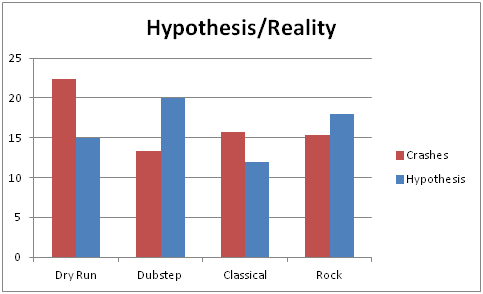
For the first group (1.) of people there was not much to see, there was no clear pattern. For the second group (2.) there was a slight pattern a decline in crashes for dubstep, but didn’t really prove anything yet. But for the third group it was clear as air that there were fewer crashes in dubstep. This was very surprising to us. We thought that because of the fast paces and viciousness, it would cause people to go fast and crash and when people crash that usually makes their time worse.
Group 1 Results (1.)
Group 3 Results (3.)
Top Speed
Speed, well that tells a totally different story than the crashes. For the speed it seems that during rock people reached a faster top speed. Between top speed and the number of crashes it seems that there are no obvious relationships. These findings, to us seem strange because I previously thought that the faster you go the more likely you are to crash, but in this case it seems irrelevant. But make no mistake; these are not the lap times nor are they the total times.
If you look at the top speed on average compared to the crashes for the dry run people tended to go slower but had more crashes. This can easily be explained. This happened because for everybody it was their first run and they were just learning the game. For dubstep the average top speed seemed to be higher but the amount of crashes was lower. This we found interesting, because usually when you go faster you tend to crash more right? Yet here we have results that show that’s not true. During classical as we expected people had a slower top speed because of the lower BPM in the song. It is also the song that’s the most consistent with the number of crashes.
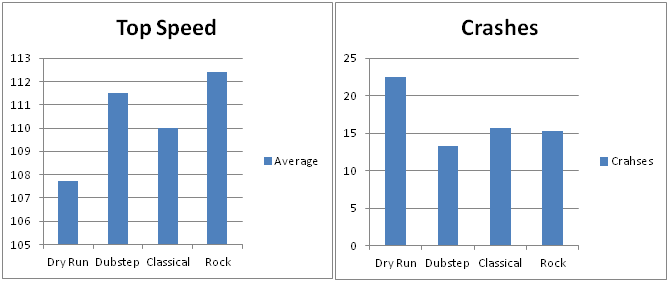
The strangest one though, out of all the songs, is rock. It has the same amount of crashes as classical but during it people reached a higher top speed than classical. If we look at both the lap times for rock and classical you can see that it actually looks like it’s like the time switch. Which we found strange, because even though it took people while listening to rock on average 6 seconds more to complete the first lap they completed the second lap 7 seconds faster than people while listening to classical
Lap Times
For times, there were no significant patterns in individual times in each group (a)(b)(c). The only chart we saw a difference on is the average (d). This displayed contrary to our hypotheses, because it displays that people did worse on dubstep and better on rock. According to the average amount of crashes, people do better when they have more crashes.Final Times
(a)Group 1
(b) Group 2
(c) Group 3
(d) Total Average
So is this evidence that the rock music (Thunderstruck) actually have an effect on people’s ability to drive. This song had 133 BPM (beats per minute). Compared to Maiden with the Flaxen hair which was 65 BPM. That’s about half the BPM of Thunderstruck.Now that we’re done looking at just the times, we can compare them to the number of crashes people had. So we found that in the dry run, the amount of crashes was higher than all the others but in comparison didn’t have a relation to the time. Then in dubstep the amount of crashes was at its lowest but the time was the slowest. Then in classical the crashes are still lower but the time is still higher. The only one that does not correspond to this time to crashes ratio is rock. But rock only has a difference in the amount of crashes to classical by a decimal number, and the amount of time it took people on average was 3:55 minutes. In comparison to classical, on average a time of 5:08, a difference of 1:13 minutes.
Conclusion
To finish found evidence that the song Thunderstruck makes people reach a higher top speed than dubstep and classical music, because Thunderstruck has a higher BPM, that people tend to crash less than expected during dubstep but take longer to finish the race. But if you want to get somewhere fast you should listen to rock. All this evidence supports the fact that our hypothesis; people would crash more during rock and dubstep but would go faster and get a better time was wrong. Along with our thoughts that while listening to classical music people would go slower, get a slower final time and crash less. That it was wrong.
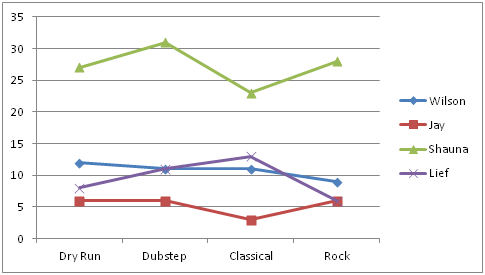
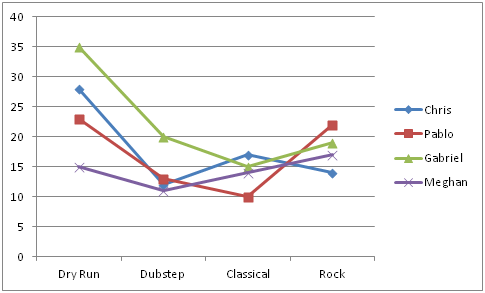
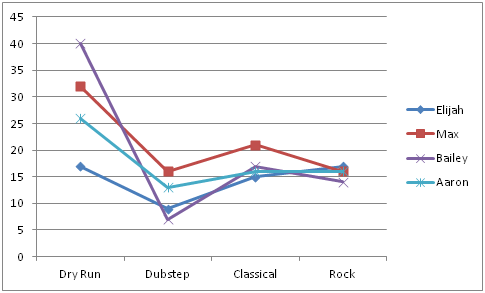
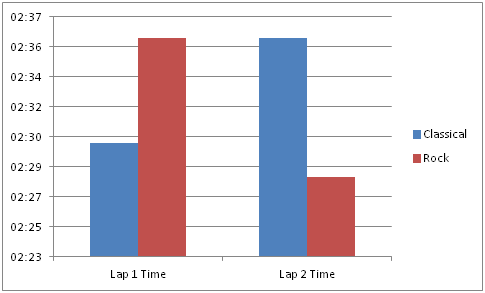
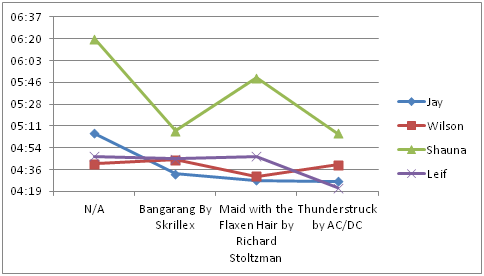
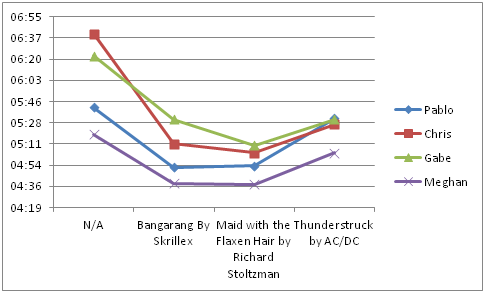
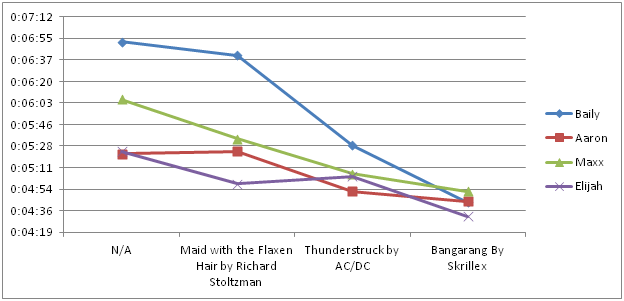
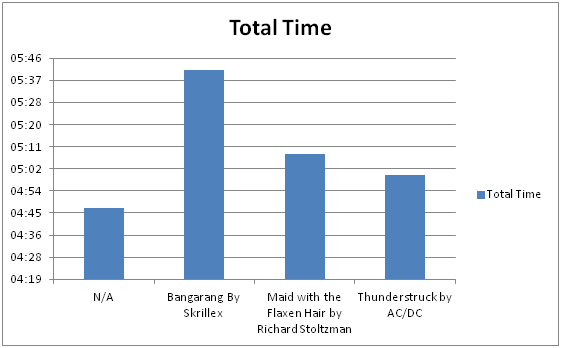
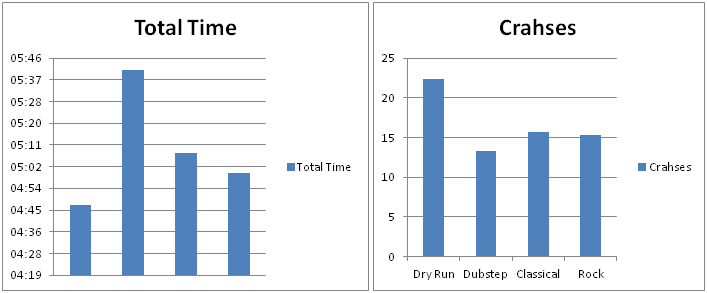
Pingback: Inquiry 3 | Liam's Blog
Pingback: Presentation Day (The real one) | Owen's Blog